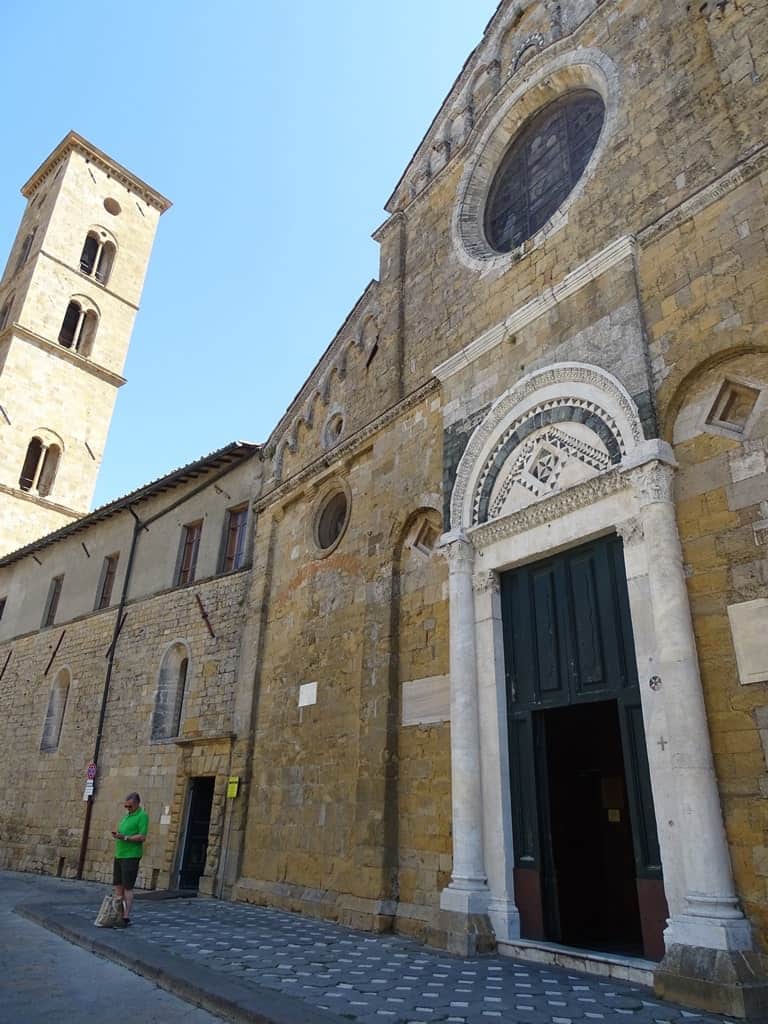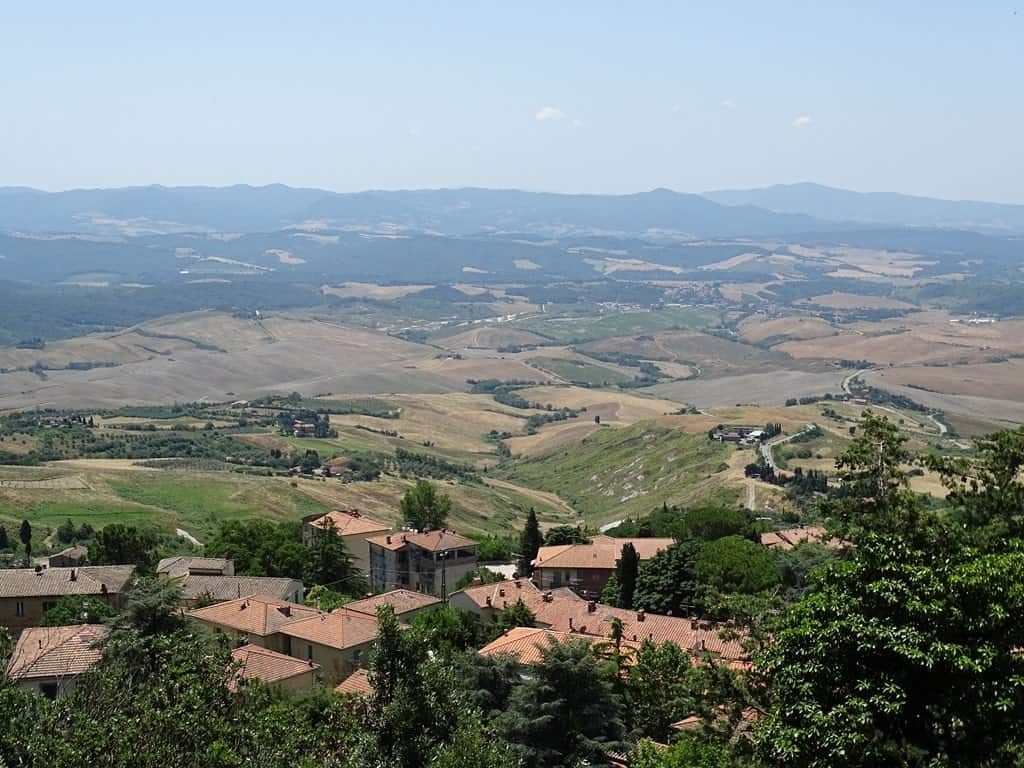Volterra is a lovely town at the heart of Tuscany, and it’s only a few miles away from Pisa, San Gimignano, Florence, and Siena. It’s one of the most popular destinations for a day trip in the countryside thanks to its medieval old town, its amazing views, its rich historical heritage, and its wines, of course!
Volterra had its golden age a very long time ago: it was one of the main Etruscan settlements, and there are still many traces of its glorious past. It’s been a prosperous town up to the Middle Ages, and there are still many buildings, churches, and picturesque corners reminding the visitors of that time.

Its charming old town has also been used as a movie set, even by famous directors like Catherine Hardwicke, who shot a few scenes from the Twilight saga right in Volterra!
Here’s a list of what you can see and do in Volterra:

Disclaimer: This post contains affiliate links. This means that should you click on certain links and then subsequently purchase a product, I will receive a small commission.
Table of Contents
Best Things to Do and See in Volterra
Watch the old buildings in Piazza dei Priori

It was the political center of the town, the market square, and the place where locals gathered on social occasions. Its many elegant buildings still show its importance: Priori Palace, which is still the mayor’s headquarters; Pretorio Palace, still housing some administrative offices; Belforti and Allegretti Palaces; the Bishop’s Residence; and one of the gates of the Cathedral.

Visit Viti Palace
This private mansion dates back to the end of the 17th century, and it belonged to a local noble family before being purchased by a wealthy merchant in the 19th century. Its owner was Giuseppe Viti, an alabaster trader who traveled extensively.
He liked to collect precious objects coming from all over the world, and he often got some gifts from his wealthy customers. His collection became a proper museum housed inside his own residence that’s still furnished with period furniture. For more information, check here.
Enter the Cathedral


The Cathedral of Santa Maria Assunta was built in 1120, and it’s an architectural masterpiece in the Romanesque style. Inside, you can see several works of art, but its wooden coffered ceiling is equally impressive. Its main entrance is located in San Giovanni Square.
Take a picture of the Baptistery.

It stands next to the Cathedral on one of the main squares of Volterra. This impressive building closely reminds the visitors of the famous Tuscan churches and baptisteries decorated in polychrome marble. It dates back to the 13th century, and it was built in Romanesque style, just like the Cathedral itself, even if it is more recent.
Visit the Guarnacci Etruscan Museum
It was established in 1761 thanks to a local nobleman named Mario Guarnacci, who wanted to share his private collection of Etruscan artifacts with his citizens. He was fond of archeology, and he spent several years searching for Etruscan ruins and items. It’s thanks to his work that we can now learn more about those people who lived in Central Italy so many centuries ago!
Visit the local art museum (Pinacoteca)
Minucci Solaini Palace houses a rich collection of local art, including some precious paintings dating back to the Middle Ages and the Renaissance. There are also several temporary exhibitions aiming at displaying local painters’ works. Click here for more information.
Take a picture of Porta dell’Arco

It’s the only preserved Etruscan gate we can still admire in its original shape. It’s made of three types of stones in three different colors (yellow, light grey, and dark grey), and it’s decorated with three human heads. It’s unclear who they represent, but they were probably some Etruscan deities.
Climb up to the Medici’s Fortress

It overlooks Volterra from the top of a hill, and it was built in 1474 when the town was conquered by the Florentines. It was built to hold off the local people and to avoid uprisings and disorders. An area of the fortress named Rocca Nuova was also converted into a prison intended for the enemies of the Medici family. Today, only the Tower and the park are open for visits because the fortress is still used as a prison!
Walk by the ancient walls.

The Etruscan walls were built in the IV century BC, and they were 7 Km long. Unfortunately, they were almost entirely destroyed and replaced by medieval walls that were only 2,6 Km long.
Look for Docciola Spring

It’s located next to Docciola Gate, and it dates back to 1245. Its purpose was to bring water to the mills driving the local flourishing textile industry. It’s still one of the favorite meeting points of locals.
Take plenty of pictures from the belvedere.

The panoramic terrace located in Piazzetta dei Fornelli is the best spot for your Insta-friendly pictures! It offers a great view of the countryside, and you can even see the Mediterranean Sea in the distance on clear days.
Visit an alabaster workshop.

Volterra has always been famous for its alabaster. There are still several craftsmen’s shops and workshops where the stone is worked and turned into artistic masterpieces or souvenirs for visitors! You can visit the Rossi Alabastri workshop and take a step back in time while learning more about traditional working techniques.
Watch the ruins of the Roman Theater.

It was discovered in the 50s, and it’s now the main piece of Roman heritage in the area. It could accommodate up to 3500 people, and there are still some traces of the mechanism used for covering the audience with a temporary roof. The theater was closed in the 3rd century BC, and it was converted into a thermal bath.
Visit the Etruscan Acropolis

The ancient Acropolis, which is the most sacred place in town for the Etruscan people, was located on top of the hill. There are still some ruins belonging to their temples and dating back to the VII century BC. An elevated position was important for the Etruscan priests because they used to rely on the interpretation of the flight of birds or lightning. There are not many Etruscan ruins left because they used wood and clay instead of stone to build their temples and palaces.
Watch the landscape through Staccioli’s Circle.
While driving around the countryside near Volterra, you’ll notice some contemporary art installations. They were placed there by Mauro Staccioli, a local artist who became quite famous for that. One of the most popular ones is located on the top of a hill, Poggio San Martino. It’s a red circle intended to be a sort of frame to watch the countryside below.
Have a stroll in the old town


Its narrow alleyways and its lovely squares are perfect for an early morning stroll before they get too crowded and chaotic. The streets are lined with gift shops, wineries, and craftsman’s shops.
Enter the Chapel of the Cross

Next to the Church of S. Francis, this small chapel deserves a stop to watch its frescoes covering its walls from floor to ceiling and representing some very detailed biblical scenes.
Enjoy a wine tour
You cannot visit Tuscany without tasting some local wines! You can choose from several wine tours taking you to the best wine estates, wineries, and vineyards. One of the best ones will take you to the small village of Bolgheri, located 40 km from Volterra and easily reachable by car Bolgheri: Winery Tour with Wine Tasting,
Take a day trip to the Cecina River.

If Tuscan summer feels too hot and you dream of a swimming pool, then drive to the Cecina River and swim in its natural pools! There’s a natural reserve only 30 km away from Volterra, and it’s a perfect place to sunbathe and enjoy the cool water of the river in a safe environment. You’ll have to walk up a trail to reach the beach, but it’s easy, and it’s suitable even for young kids.
Take a day trip to Siena.

Siena is only 55 km from Volterra, but you’ll need a car to get there since there are no trains available. Siena is the closest and the most easily reachable destination from Volterra, and it’s so small that it can be visited in only one day! Don’t miss Piazza del Campo, the Cathedral, the Baptistery, and the famous Mangia Tower.
You might like the following: One day in Siena.
Attend the medieval festival named Volterra 1398
A colorful medieval festival turns the old town into a true medieval setting with themed shows, markets, parades, and folk music. The festival takes place every year on the second and the third Sunday of August. Click here for more information.

